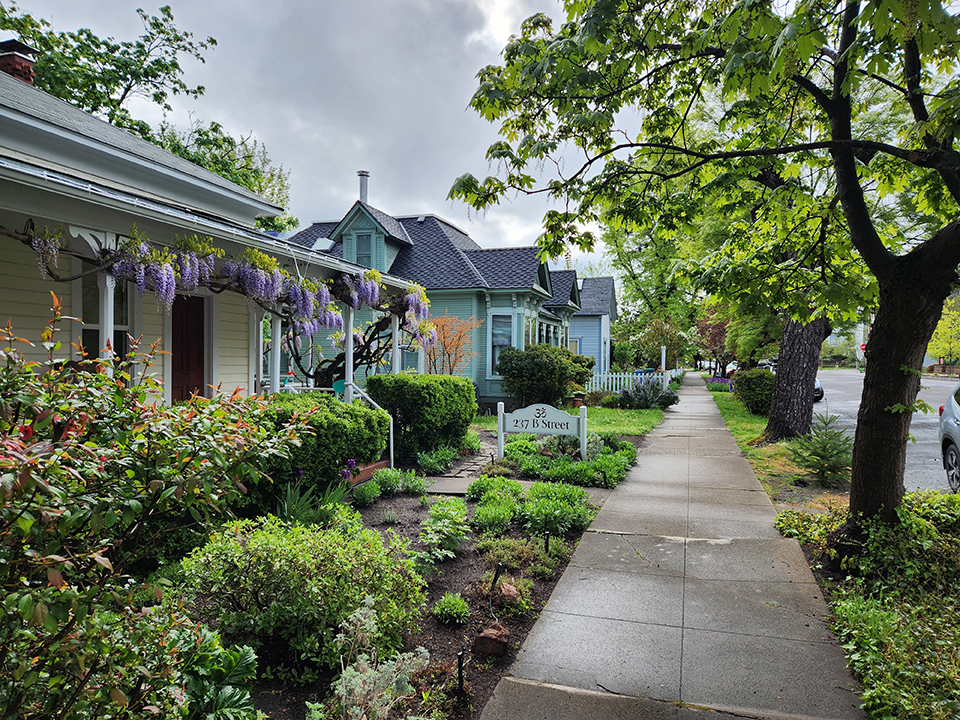
Ashland’s Historic Railroad District is just one example of Oregon’s historic districts and Main Streets potentially threatened under provisions in HB 3414. (Image courtesy of George Kramer)
Call to Action - Oppose:
HB 3414 Would Jeopardize Historic Protections and Design Regulations Statewide and Undermine Local Review
Please join Restore Oregon in lending your voice in opposition!
On May 9th, the House Rules Committee took public testimony on the Governor-sponsored House Bill 3414 which requires local governments to approve, developer-requested by right (meaning no threshold criteria for qualification), variances (also known as adjustments or modifications) to land use regulations related to the siting and design of housing developments. Such variances are often already allowed by local governments, contingent on the applicant demonstrating how an alternate method of compliance would still uphold development standards codified in the local zoning code.
As currently proposed, HB 3414 would allow developers to bypass city codes and processes in place to protect our built and natural resources, including regulations governing the alteration of landmark properties and new construction in designated districts, without demanding any increased density or level of affordability. Although the current version of the bill includes a list of exceptions that allow regulations relating to density, height, and floor-to-area ratio to remain, all other protections in place to avoid incompatible new development will no longer apply, if a developer asks for a variance under HB 3414. This would eliminate design compatibility protections such as massing, orientation, materials, windows, character-defining features, and stylistic detailing, as well as setbacks and tree preservation obligations for new residential development in every zone where residential uses are allowed. HB 3414 authorized variances will occur with no public notice and other than for the developer, there is no right to appeal.
While the stated intent is to spur more housing production, it’s conceivable the results would do exactly the opposite. Whatever cost savings a developer may realize as a result of eliminating windows, trees, and setbacks do not need to be passed on to any future residents. There are many ways that we can support streamlining and incentivizing housing in a preservation- and climate-friendly manner while not sacrificing our existing resources – both built and natural. We are committed to this effort but not at this high and extreme cost.
Restore Oregon currently opposes this version of the bill and is working to change its impact.
We need your help too.
Three Mayors, including historic preservationist Denyse McGriff of Oregon City, have called to shelve this bill (Letter to the Editor)
Please lend your voice in opposition the variance component of HB 3414.
Submit testimony ASAP! Click here and submit a letter.
OR, using “Text Testimony,” you can type a short statement directly into the system. Takes less than 5 minutes.
All testimony is helpful and can be submitted up to 48 hours after the hearing – no later than 1 pm on Thursday.
Some points that might serve as the focus for your testimony include:
- The impacts from by-right adjustments will be highly visible and will be felt in every neighborhood, in every community, and throughout the state and will not necessarily result in a greater quantity or more affordable housing.
- HB 3414 would not only nullify all of the detailed effort in removing barriers to housing within historic, natural and scenic protected areas, it would continue a well-established trend of displacement and gentrification of culturally diverse areas that deserve continued protection
- By-right adjustments as authorized in HB 3414 will not increase the overall supply of housing, housing affordability, nor increase housing choice – there is no requirement in the bill that the adjustment be tied to production of additional housing that would otherwise be allowed.
- Many design standards and criteria are culturally responsive and protect diverse and underrepresented histories from erasure from market-rate development.
- Historic resources are unique assets for local communities and their long-term preservation requires adherence with longstanding protection rules.
- Archaeological resources require delicate attention, such as regulations governing avoidance of Native American sites.
- Design standards for Main Street and downtown areas are necessary to ensure these special places remain walkable and economically thriving commercial cores of Oregon’s communities.
- Preservationists throughout the state have worked collaboratively with local governments on sensible regulations and procedures that allow new residential development in historic areas.
- By-right adjustments will break community trust of local government officials and staff undermining decades of collaboration.
- By-right adjustments undermine a clear and implementable land use system that already includes local variance and adjustment standards allowing for a relief valve when circumstances dictate.

